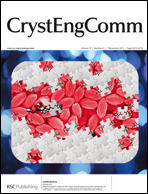Single crystalline brookite titanium dioxide nanorod arrays rooted on ceramic monoliths: a hybrid nanocatalyst support with ultra-high surface area and thermal stability
Abstract
In this study, a cost-effective solution synthesis of commercial scale single crystalline titanium dioxide (TiO2) nanorod arrays has been successfully achieved on the inner walls of cordierite monoliths, which may provide a new class of nanostructured hybrid support for catalysis and energy applications. The morphological evolution has been observed from dandelion TiO2 nanorod clusters to vertically aligned nanorod arrays while increasing the solution treatment time. A heterogeneous nucleation–dissolution–crystallization mechanism is proposed for the growth of the brookite structured TiO2 nanorod arrays on the inner walls of honeycomb monoliths. The brookite structured TiO2 nanorod arrays have a high surface area up to ~250 m2 g−1, with an overall specific surface area in the hybrid nanostructured monolith increasing by 1.8 and 2.5 times after TiO2 nanorods coating for 4 h and 24 h, respectively. The thermal stability tests using differential scanning calorimetry (DSC), thermogravimetric analysis (TGA) and hydrothermal stability tests under boiling water for 24 h suggest that the TiO2 nanorods coated hybrid monoliths are very stable. An as-prepared 9-cm-long TiO2 nanorod-array monolithic device was demonstrated as a continuous flow fixed-bed absorbent with efficient performance in Rhodamine B removal from aqueous solution.


 Please wait while we load your content...
Please wait while we load your content...